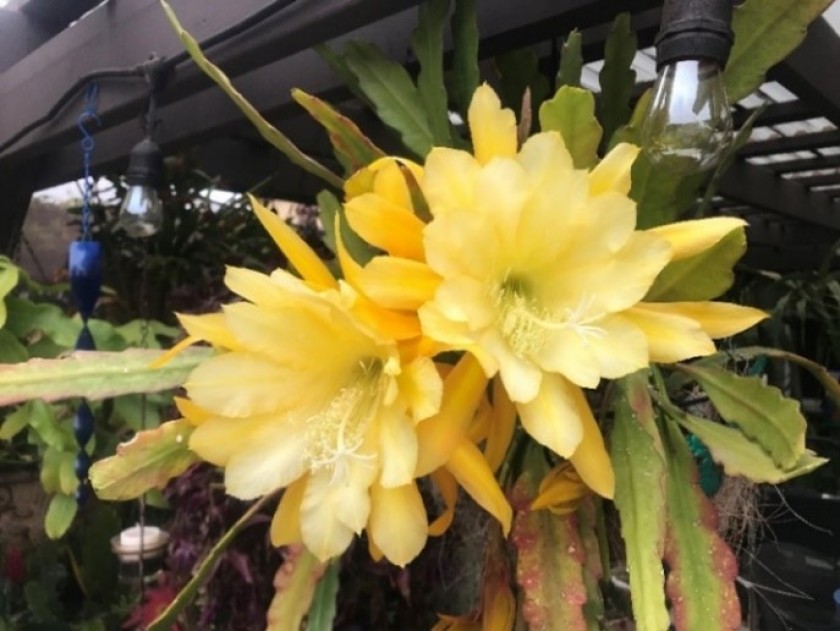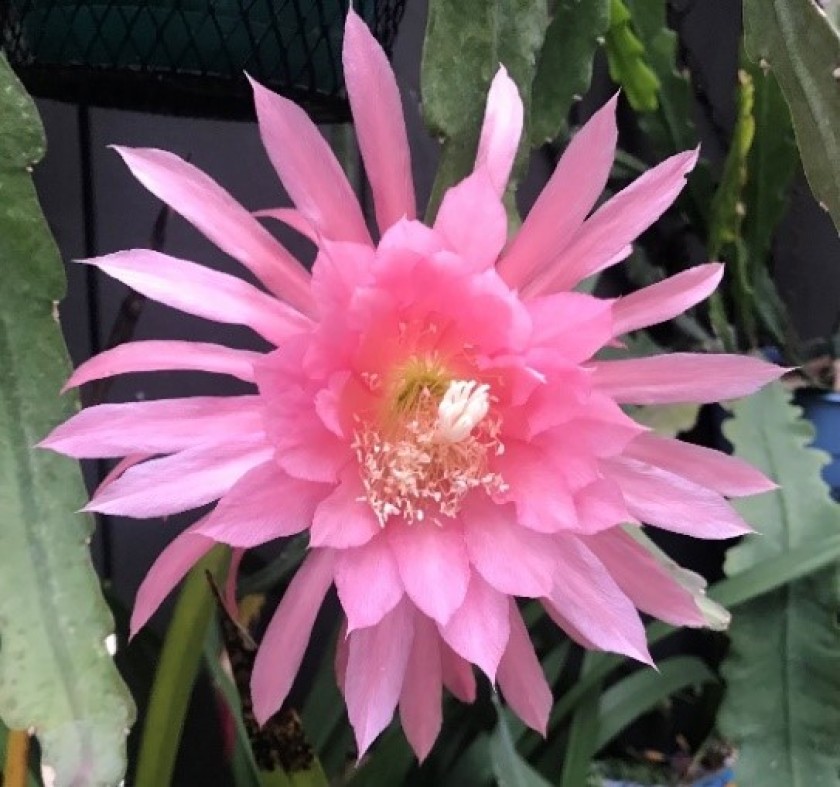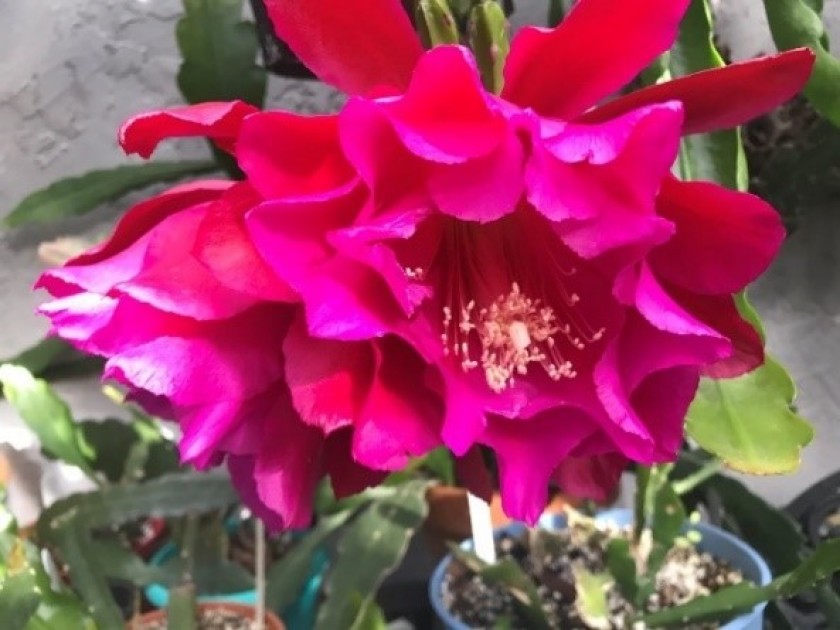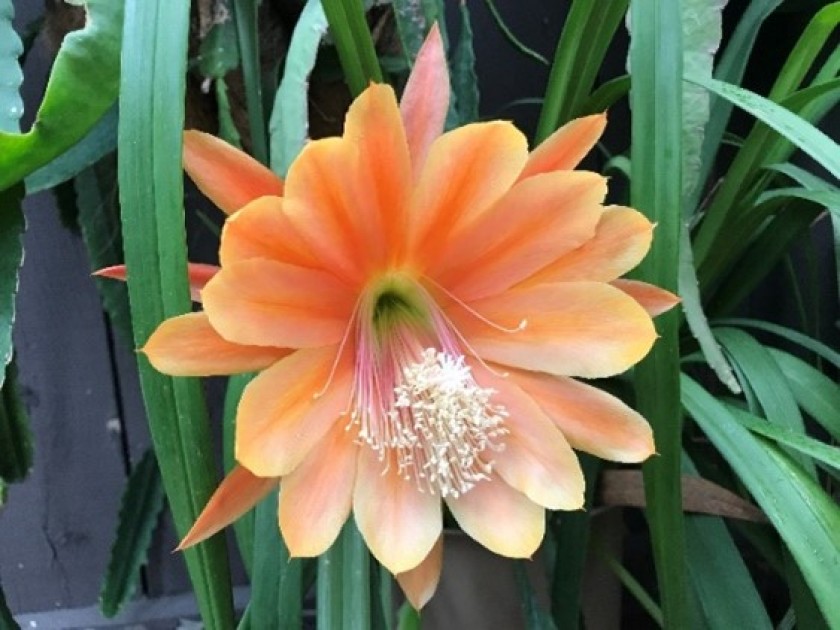Get show stopping blooms from Epiphyllum hybrids

Epiphyllum hybrid ‘Going Bananas’(Gretchen Ward)
BY GRETCHEN WARD
The popularity of Epiphyllum hybrids has increased in recent years, and if you’ve seen their dramatic blooms, it’s easy to understand why.
The species ancestors of hybrids grown today originated primarily in the tropical regions of Mexico and Central America. Today, however, with the advent of online sales and the widespread acquisition of cuttings, they are being grown by people around the world. On social media, collectors and hybridizers share information and the joy of their hobby.

Epiphyllum hybrid ‘Beauty Queen’(Gretchen Ward)
Epiphyllum hybrids, or “epies,” as they are fondly known, are fairly easy to grow from cuttings, given the right conditions. They are epiphytic tropical cacti, and most grow best when in a hanging pot, where their long stems can dangle. Recent molecular analysis of hybrid DNA has confirmed that most of what we call epi hybrids are actually not descended from Epiphyllum species as we had thought in the past, but instead are primarily derived from either Disocactus or Selenicereus.
Tropical cacti do not tolerate drying out completely, like their desert cacti cousins. They prefer shade and will sunburn if left in direct sunlight. They grow stems and branches — but not leaves. The spines on an epi are actually modified leaves and the flowers emerge from areoles, just like any other cacti. Their flowers are “perfect” as they have both male and female parts.
When you receive that cutting you have longed for, be prepared to wait three to four years before you will see a bloom, but it is worth the wait.
Epies have some basic needs:
Air: Good air circulation around plants and in the soil will keep plants healthier.
Light: Plants in too much shade do not bloom. Dappled or indirect light is best. Avoid noonday direct sun.
Water: Epi hybrids grow well if they have adequate water. They should be kept moist at all times, but not soaking wet. Reduce watering during cooler months and water only as needed in winter.
Nutrients: It is wise to provide for a slow, steady release of nutrients in your soil mix. Fertilize as needed, because nitrogen supply is a critical factor.
Potting mix: The best potting mix for epiphytic plants should contain organic matter and should have a slight acid pH and be porous.
Roots: A well-developed root system promotes blooming.
Temperature: The ideal temperature range is 50 degrees to 80 degrees. They tolerate lower and higher temperatures, but they may need more water in the heat, and a hard freeze will kill an epi.

Epiphyllum hybrid ‘Frida Kahlo’(Gretchen Ward)
After you obtain a cutting, allow it to callus for up to 10 days, then place it in a 4-inch pot of well-draining soil made up of thirds of potting mix, perlite and either small orchid bark or coconut fiber. Do not water the cutting until you feel the tug of roots when gently pulling up on the cutting. You can occasionally mist the cutting before the roots form if the weather turns warm.
Once the roots are growing, it is safe to water. Keeping a plant too wet presents the risk of causing rot. When you are sure you have roots, then you await new growth; after that, it is time to pot up to a gallon-size container.
When you have a well-rooted plant, how do you make it give you gorgeous flowers? The key to having lots of healthy growth and blooms is to fertilize properly. With epies, a weak application of fertilizer is best, so start the year off with about a half-teaspoon of granular fertilizer per gallon pot, beginning in late January. A low-nitrogen fertilizer, such as a 0-10-10 NPK (nitrogen, phosphorus, potassium), provided in early spring will help boost flower production.
Once plants have finished their bloom cycle, apply a like amount of a balanced fertilizer such as a 5-5-5 or a 10-10-10. Be careful to not overfertilize, as too much can harm the plant. Let your epi rest in the winter months when plant growth slows with lower temperatures, and there is no need to fertilize. Do not expect a lot of flowers while the plant is still young. As the plant grows and continues to mature, subsequent years should provide multiple blooms.

Epiphyllum hybrid ‘King Midas’(Gretchen Ward)
Plant labeling of hybrid names is another consideration for those who want to collect and trade epis with other enthusiasts. Keep your plants labeled. The serious epi collector pays close attention to the registered name of the flower and protects the identity so other collectors will know what it is you are selling or sharing. Without a name tag, a flower becomes an unknown, making epi collectors reluctant to acquire such a flower. So, keep your name tags straight and enjoy growing epis with others. They are so worth it when the blooms show themselves in the spring.
If you are interested in growing Epi hybrids, there are sources online and on social media where they can be purchased. The San Diego Epiphyllum Society usually has a sale in Balboa Park every Mother’s Day weekend, and occasionally the plants can be found in local nurseries, but the days of specialized nurseries where you can shop just for epies in person are mostly gone. Information on growing these amazing plants can be found on the San Diego Epiphyllum Society website at https://sdepis.org.
Ward recently retired from a 35-year career with the National Park Service as a program manager, archaeologist and park ranger. She is a San Diego native and has been a lifelong gardener. Ward is a Master Gardener with the San Diego County Master Gardener Association and completed the University of California Cooperative Extension (UCCE) Master Gardener program in 2020. She has raised and worked with epiphytic plants for most of her life, having inherited epiphyllum hybrids from her mother. Ward is the current president of the San Diego Epiphyllum Society.

